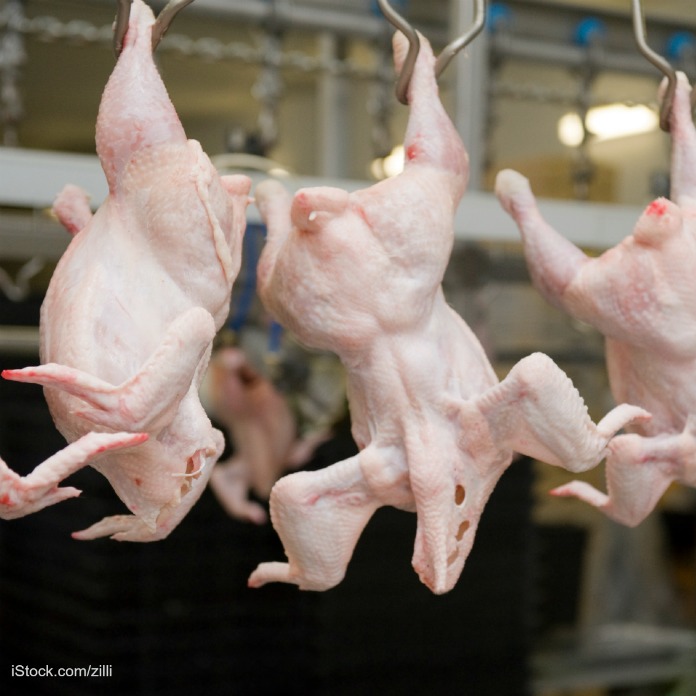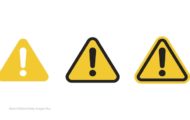U.S. Secretary of Agriculture Tom Vilsack and Under Secretary for Food Safety Dr. Elizabeth Hagen held a press conference on January 20, 2012 attended by Food Poisoning Bulletin where they discussed a proposed modernization of poultry slaughter inspection methods.

The plan would concentrate Food Safety Inspection Service (FSIS) resources on the parts of the poultry processing system that pose the greatest risk of foodborne illness. The FSIS is no longer going to have inspectors focus on quality assurance, which they say is mainly concerned with cosmetic appearance, but will instead focus on food safety issues. Vilsack claims that peer-reviewed risk assessments have shown that this change could prevent up to 5200 foodborne illnesses per year.
The modernization plan includes these items:
- Currently, some FSIS inspectors look for visual defects such as bruising. Under this proposed plan, those issues will be the responsibility of the corporation.
- FSIS inspection activities will focus on critical food safety tasks, mainly off-line inspections.
- Some regulatory requirements are being replaced with more flexible and effective testing and process control requirements.
- All poultry processing establishments will have to ensure that their processing procedures prevent contamination with supporting data.
The government estimates that this change will save the FSIS $15 million dollars per year in the first year and up to $35 million in the next two years. The change will affect 2500 people employed by FSIS. About 1500 will have their positions upgraded. About 500 to 800 inspection positions and 140 supervisory positions will be phased out over 3 years by attrition.
The new rule should also lower production costs by $250 million per year since the line production speed will increase to 200 birds per minute. Dr. Hagen stated that, “the plan has been operational in a limited number of plants for some time.” She also stated that this change is being proposed “on the basis of experience, the pilot project, and peer-reviewed quantitative risk-assessment reports.” A study on faster line speeds and worker safety will be added to the rule. And she said a detailed cost-benefit analysis of this rule will be posted on the FSIS website later today.
This program is voluntary, although the chicken industry is in favor of the plan. The FSIS expects that about 200 poultry establishments, out of the 300 that currently exist in the United States, will participate in the program.
The consumer group Food and Water Watch opposes this new measure. Through the Freedom of Information Act, they found that current regulations aren’t being enforced by inspectors. They said, “This plan by USDA illustrates how much power the meat industry has inside this agency.” The group called on the USDA to abandon the plan and put consumer protection above industry interests.
Outbreaks of Salmonella in poultry continue, including an outbreak in Cargill ground turkey in 2011 that sickened more than 130 people and killed one person. That contamination prompted the recall of 36 million pounds of turkey.
Secretary Vilsack stated that the agency will continue to conduct on-line carcass-by-carcass inspection as the law requires. There is a 90 day comment period on the proposed rule change, which will begin when the proposal is published in the Federal Register. To comment, visit Regulations.gov and search for “poultry inspection”.





i have worked in a processing plant started in 1993 to 3/30/2012. and what i see is that taking the inspectors off the line which they were doing detailed inspections of Leukosis, airsacculitis, and septicemia/toxemia and imflammatory process. would not be in the best way to go.not only the diseased birds but all the other stuff,feathers.and other things.And with the cost per pound they could let it go on purpose to save cost of contamination.the efficiency would go up but also would the trash going out, but by keeping the inspectors on line would stop that.
I have worked in the poultry industry for more than 30 years, both for poultry companies and for USDA>
The USDA/FSIS inspectors on the line are responsible for checking for more than food quality defects.
The inspectors examine hands-on the outside of each bird, the visceral cavity, and the viscera at 35 birds per minute, with the defective birds immediately being removed from the line
They check for pathology, mutilation, and contamination.
The diseased birds that have nasty diseases such as Leukosis, Imflammatory Process, Airsacculitis,and Septicemia/Toxemia, are immediately removed from the line.
Cadavers, or birds that were hung on the line dead by the plant are removed. Cadavers are often putrified and stink, though they are sometimes hard to detect with just a quick visual look.
With the new inspection system, the plant would be responsible for removing diseased, mutilated, and cadaver birds from the line. There is an inherent conflict in the plant doing this because they are concerned with cost per pound, efficiency, and so forth.
With the proposed new inspection system, the USDA inspector would be at the end of the line looking at the birds as they pass by at 140-180 birds per minute, checking mainly for fecal contamination,
There would be no hands-on carcass by carcass examination.
There would be no examination of the viscera, or the inside of the body cavity where many diseases can be detected.
It is a stretch to call this a carcass by carcass inspection.
Thanks so much for your informative comment. Here, we’re just reporting the news. It’s readers like you who add so much to the story. After all, as our mission statement says, we just want the food in this country to be as safe as possible.
First of all I’m no inspector nor do I work in a plant but I do know a little about how it works, unlike some who express theirselves. Undoubtedly you have never been in a poultry plant! Fsis inspectors not only look for cosmedic defects (bruising,sores, scabs and etc) but have you ever heard of things like airsacculitis, arthritis, ascites, avian leukosis complex, avian tuberculosis, cadaver, enteritis, erysipelas, inflammatory process, nephritis, osteomyelitis, other tumors (carcinoma, sarcoma, etc.) pericarditis, pneumonia, reportable disease, salpingitis, tenosynovitis. THESE ARE WHAT THE INSPECTORS REALLY TRY TO PROTECT YOU FROM! You can NOT see these things when the birds pass by at 100-200 per minute. Someone needs to use COMMON SENSE or no one will be able to eat chicken anymore.